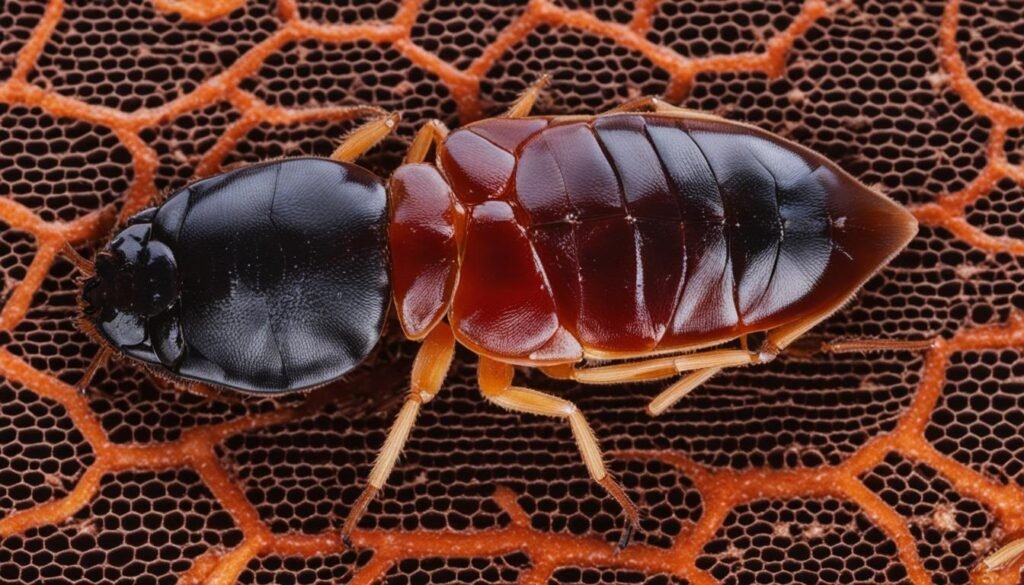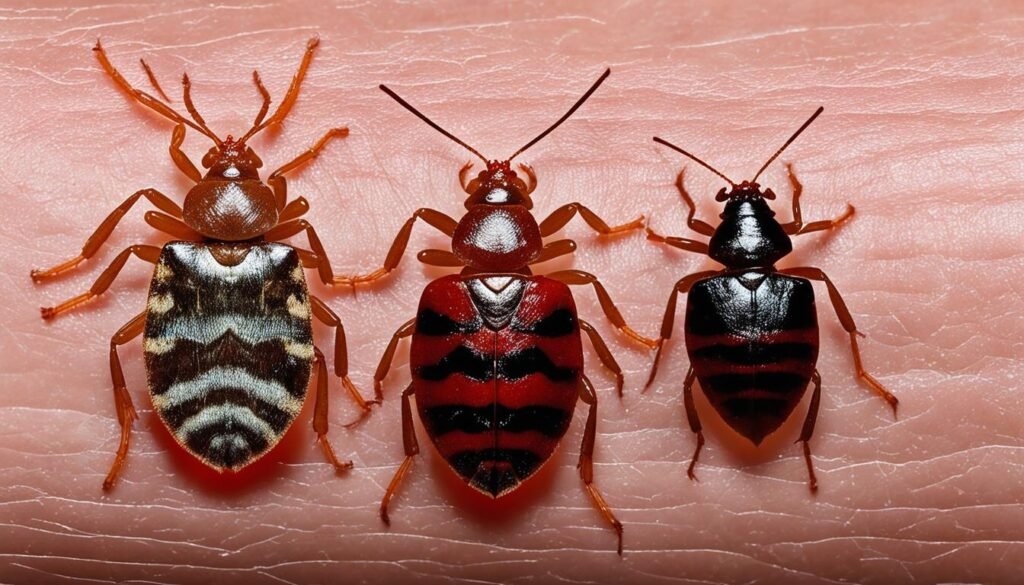Bed Bugs vs Nits
Table of Contents:
When it comes to dealing with infestations, it’s essential to identify the culprit correctly. In the case of small, bothersome pests like bed bugs vs nits, understanding the differences between them is crucial for effective eradication. While they may seem similar at first glance, several key factors set them apart.
Bed bugs are larger than nits, measuring about a quarter inch in length. They have a distinct brownish-red or mahogany color and a flat, oval body shape. On the other hand, nits are smaller than an eighth of an inch long and have a whitish or grayish color. They are often attached to hair strands, near the scalp, resembling small, light-colored eggs.
The location of these pests also differs. Bed bugs tend to hide in the seams of mattresses and furniture, while nits are typically found attached to hair strands. Additionally, the effects on humans vary. Bed bugs feed on blood for a few days before a skin rash appears, causing itching and skin irritation. Lice, on the other hand, require blood every day or so to survive, leading to constant itchiness and irritability.
Understanding these distinctions is crucial for addressing infestations effectively. By correctly identifying bed bugs and nits, you can take the necessary steps to eliminate them from your home and prevent further problems.
Bed Bugs vs Nits Key Takeaways:
- Bed bugs are larger and have a brownish-red or mahogany color, while nits are smaller and have a whitish or grayish color.
- Bed bugs hide in the seams of mattresses and furniture, while nits are usually found attached to hair strands, near the scalp.
- Bed bug bites cause a delayed skin rash, while lice bites result in constant itching and irritability.
- Effective eradication methods differ for bed bugs vs nits, with professional pest control often required for bed bugs.
- If unsure or facing difficulties, seek professional help from experienced pest control or lice treatment experts.
Bed Bug Identification: Size, Color, and Shape
When it comes to identifying bed bugs, their size, color, and shape are key factors to consider. By understanding these characteristics, you can effectively differentiate between bed bugs and other pests like nits.
Bed bugs are relatively larger, measuring about a quarter inch in length. This size sets them apart from nits, which are smaller in comparison. The adult bed bugs are brownish-red or mahogany colored, with flat, oval bodies. However, it’s important to note that the color may vary based on factors such as their life stage and recent feeding activities.
Unfed bed bugs have a thin and elongated appearance, while fed bed bugs become more plump and balloon-like in shape. This unique transformation after feeding distinguishes them from nits, which typically have an oblong shape.
“By examining the size, color, and shape of the pests you find, you can accurately determine whether they are bed bugs or nits.”
By examining the size, color, and shape of the pests you find, you can accurately determine whether they are bed bugs or nits.
Visual Reference: Bed Bug Identification
Take a look at the following image to get a better understanding of bed bug identification:
Nit Identification: Size, Color, and Location
When it comes to identifying nits, their size, color, and location are key factors to look for. Nits are smaller than bed bugs, measuring less than an eighth of an inch long, making them quite tiny. They often resemble small, light-colored eggs that are stuck to strands of hair. The color of nits is typically whitish or gray, which sets them apart from the brownish-red or mahogany color of bed bugs.
Unlike bed bugs, which hide in mattresses and furniture, nits have a specific location. They are usually found attached to hair strands, especially near the scalp. This proximity to the scalp is important to note when identifying nits.
To further aid you in distinguishing between nits and bed bugs, let’s take a closer look:
- Nit Size: Nits are smaller than bed bugs, measuring less than an eighth of an inch long.
- Nit Color: Nits are whitish or gray, resembling small, light-colored eggs.
- Nit Location: Nits are commonly found attached to hair strands, particularly near the scalp.
By understanding these distinctive features, you can confidently identify nits and differentiate them from bed bugs. The visual representation below provides a clearer comparison:
| Nit | Bed Bug |
|---|---|
 |
Bed Bug Bites vs Lice Bites: Symptoms and Effects
Bed bug bites and lice bites have different symptoms and effects on humans. Understanding these distinctions can help you identify the source of the infestation and seek appropriate treatment.
- Bed Bug Bites: Bed bug bites often appear as red, itchy marks on various parts of the body, such as the arms, legs, and torso. One characteristic pattern associated with bed bug bites is the “string-of-pearls” arrangement, where multiple bites form a line or cluster. These bites typically take up to 14 days to develop after being bitten. In addition to the bites themselves, other signs of a bed bug infestation include blood stains on bedding and a musty odor in the affected area.
- Lice Bites: Lice bites are limited to the scalp and are characterized by intense itching. If you notice persistent itching and irritability, especially near the scalp, it could indicate a lice infestation. The presence of nits, which are lice eggs, near the scalp is also a common sign of lice bites. Nits often resemble small, whitish or gray-colored eggs attached to hair strands.
To help you visually distinguish between bed bug bites and lice bites, refer to the following table:
| Bed Bug Bites | Lice Bites |
|---|---|
| Red, itchy marks on various parts of the body | Itching limited to the scalp |
| String-of-pearls pattern | Presence of nits near the scalp |
| Take up to 14 days to develop | – |
| Blood stains on bedding | – |
| Musty odor | – |

In summary, recognizing the distinct symptoms and effects of bed bug bites and lice bites is essential in determining the type of infestation you may be facing. If you are unsure, it is recommended to consult a professional pest control or lice treatment expert who can accurately identify the source and provide effective solutions for elimination and prevention.
Conclusion: Addressing Infestations and Seeking Professional Help
Dealing with infestations of bed bugs and lice can be a challenging and unpleasant experience. While there are shampoo treatments and home remedies available for lice, bed bug infestations often require professional pest control services for effective eradication and prevention. The process of bed bug extermination involves using specialized methods to eliminate the bugs and ensure a pest-free environment in your home. On the other hand, treating lice requires thorough nit removal to prevent reinfestation and achieve long-lasting results.
If you find yourself unsure about the infestation or facing difficulties in eradicating the pests on your own, it is highly recommended to seek professional help from experienced pest control or lice treatment experts. These professionals have the knowledge, expertise, and tools required to effectively address the situation and provide you with the peace of mind that comes from having a pest-free home. By relying on their professional services, you can ensure a thorough and efficient approach to bed bug extermination, nit removal, and overall pest control.
Remember, when it comes to infestations of bed bugs and lice, it’s crucial to take action promptly. Ignoring the issue or attempting to handle it without professional assistance can lead to more extensive and prolonged infestations. So, if you’re facing an infestation, don’t hesitate to seek the help of professional pest control experts who can provide you with the necessary solutions to address the problem effectively and efficiently.
FAQ
What are the differences between bed bugs vs nits?
Bed bugs are larger than nits, measuring about a quarter inch in length, while nits are smaller than an eighth of an inch long. Bed bugs are brownish-red or mahogany colored, while nits are somewhat light whitish or gray in color. Bed bugs have flat, oval bodies, while nits are oblong. Bed bugs tend to hide in the seams of mattresses and furniture, while nits are usually found attached to hair strands.
How can I identify bed bugs?
Bed bugs can be identified based on their size, color, and shape. Adult bed bugs are about a quarter inch in length and have flat, oval bodies. They are brownish-red or mahogany colored. When unfed, bed bugs are thin and elongated, but after feeding, they become plump and more balloon-like in shape.
How can I identify nits?
Nits can be distinguished from bed bugs based on their size, color, and location. Nits are smaller than bed bugs, measuring less than an eighth of an inch long. They are whitish or gray in color and often resemble small, light-colored eggs stuck to strands of hair. Nits are usually found attached to hair strands, especially near the scalp.
What are the symptoms and effects of bed bug bites?
Bed bug bites often appear as red, itchy marks on various parts of the body, particularly in a string-of-pearls pattern. These bites may take up to 14 days to develop, and other signs include blood stains on bedding and a musty odor.
What are the symptoms and effects of lice bites?
Lice bites are limited to the scalp, causing itching, irritability, and the presence of nits near the scalp.
How can I address infestations of bed bugs and lice?
Bed bug infestations often require professional pest control services for effective extermination. For lice, thorough nit removal is crucial to prevent reinfestation. If you’re unsure or facing difficulties, seek professional help from experienced pest control or lice treatment experts.